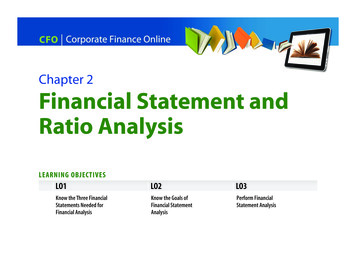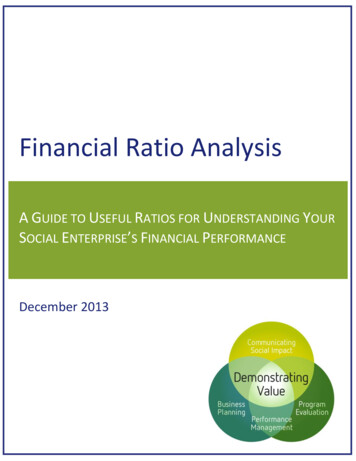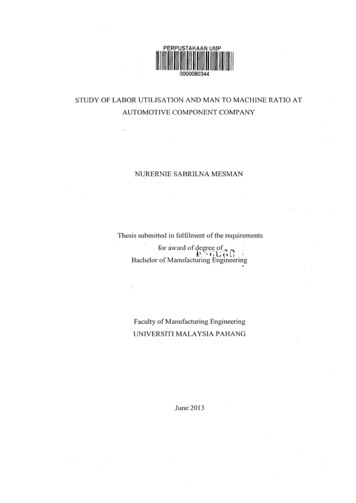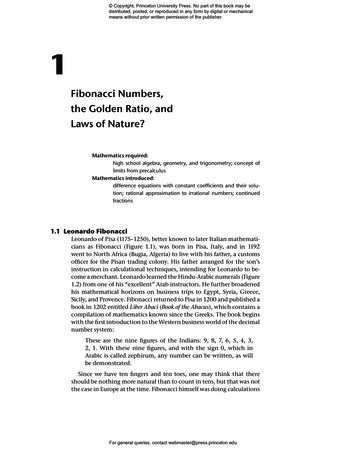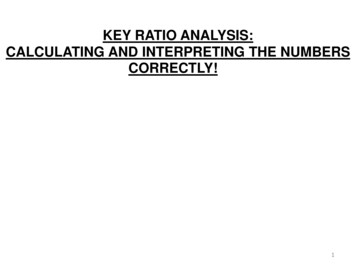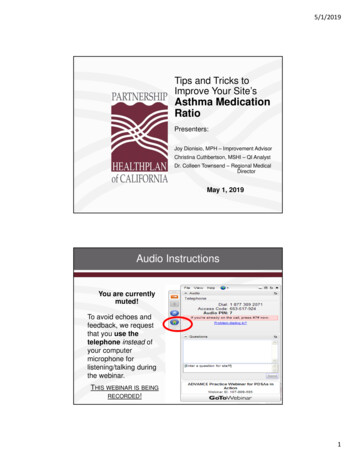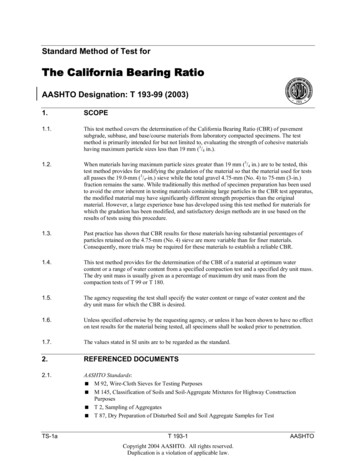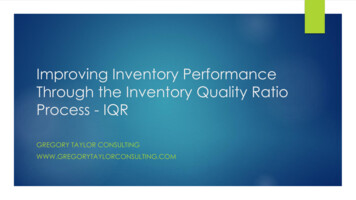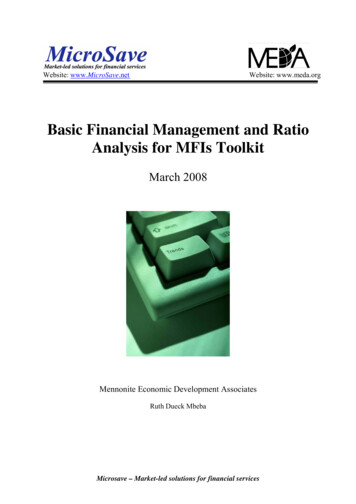
Transcription
Website: www.MicroSave.netWebsite: www.meda.orgBasic Financial Management and RatioAnalysis for MFIs ToolkitMarch 2008Mennonite Economic Development AssociatesRuth Dueck MbebaMicrosave – Market-led solutions for financial services
AcknowledgementsMEDA acknowledges the contribution and input of David Cracknell of MicroSave Africa inwriting and development of the overall toolkit.Many thanks to the helpful input and support from MEDA staff in making this effort possible,especially to Trudy Rejeski.A learning toolkit is never “final” as new techniques, tools and resources become available andare shared with one another. Participant feedback and comments will assist to continuallyimprove this toolkit and its resources.Microsave – Market-led solutions for financial services
MFIBasic Financial Management and Ratio Analysis for MFIspage iTable of ContentsIntroduction .11.Accounting Overview .2Accounting Conventions or Guidelines . 3Micro-Finance Accounting and Management Information Systems . 6The Chart of Accounts . 7Policies and Procedures . 10Qualified, Trained and Motivated Staff . 10External and Internal Audits . 11The Accounting Cycle . 11Trial Balance. 12Reconciliations. 12Accounting Adjustments. 12Draft Financial Statements. 132.The Financial Statements and Operational Reports .14The Financial Statements. 14Cash Flow Statements. 18Cash Flow Projections . 20The Portfolio and Operational Reports . 20Understanding the Relationships - Provisions for Loan Losses, Allowance for LoanLosses and Write-offs . 21Accounting for Loan Write-Offs . 253.Basic Financial Ratios .26Using Financial Indicators or Ratios. 26What are Ratios? . 26What are the Key Areas to Measure? . 27Profitability and Sustainability . 27Asset and Liability Management . 29Portfolio Quality . 32Efficiency and Productivity . 344.Basic Financial Ratio Analysis .37Where to Go From Here . 39Bibliography . 40MicroSave – Market-led solutions for financial services
MFIBasic Financial Management and Ratio Analysis for MFIspage iiFigures:Figure 1.1: Accounting Debits and Credits . 6Figure 1.2: Accounting System and Client Portfolio System (MIS) Microfinance . 7Figure 1.3: Sample Chart of Account Structure . 8Figure 1.4: Accounting Cycle . 11Figure 2.1 Understanding Relationships between Financial Statements . 18Figure 2.2 Portfolio Management Report Schedule . 21Figure 2.3 Sample Aging Report . 22Figure 2.4 Understanding the Relationships between Loan Losses and Write-Off Accounts . 23Figure 2.5 Illustration of Accounting for the Allowance for Loan Losses and Provisions . 24Figure 2.6 Illustration of Accounting for Loan Write-offs . 25List of Handouts:Section 1:Accounting Overview1.1 Session PlanSection 2:Financial Statements and Operational Reports2.1 Sample Income and Expense Statement2.2 Sample Balance Sheet2.3 Sample Cash Flow Statements2.4 Sample Audited MFI Statements - India2.5 Sample Cash Flow Projections2.6 Sample Portfolio Reports2.7 Sample Non-Financial DataSection 3:Basic Financial Ratios3.1 SEEP Microfinance Ratios3.2 Comparing Performance Using BenchMarking3.3 MicroBanking Bulletin Benchmarks for Asia3.4 Calculating Effective Interest on LoansSection 4:Financial Ratio Analysis4.1 CGAP Focus Note 22 – MFI Rating Systems4.2 CAMEL Rating Technical Note – ACCION4.3 GIRAFE Rating Methodology- Planet Rating4.4 PEARLS Rating - WOCCU4.5 Course EvaluationList of ExercisesSection 1: Accounting Overview1.1 Sample Transactions – Balance SheetSection 2: Financial Statements and Operational Reports2.1 Financial Statement Relationships2.2. Accounting for Loan Provisions and Write-OffsSection 3: Basic Financial Ratios4.3 ACME-MDI Case Study Part IMicroSave – Market-led solutions for financial services
MFIBasic Financial Management and Ratio Analysis for MFIs3.1 Team Activity – A “Financial Bee”3.2 Case Study – Delinquency Management3.3 Competition and Efficiency vs. EffectivenessSection 4: Financial Ratio Analysis4.1 ACME-MDI Case Study4.1 ACME-MDI Case Study – Ratios template4.2 Ratios and Trends4.2 Ratios and Trends – Sample Answers4.3 Sensitivity AnalysisMicroSave – Market-led solutions for financial servicespage iii
MFIBasic Financial Management and Ratio Analysis for MFIsSection 1 - 1Introduction“Isn’t the repayment rate the most important ratio I need to know?”“My MIS generates the ratios that I need! Why do I want to knowmore?”Do these comments and questions sound familiar? Microfinance ratios often include a few popularratios like the repayment rate, the operating self-sufficiency and the portfolio at risk. In general, theyspeak to the ratios that are commonly looked at as benchmarks in the early days of an institution.Other MFI managers may rely on their Management Information System that automatically producesratios with information from financi al statements and the portfolio loan tracking system. In general,they m ight understand what num bers and anal ysis is taking place, but the prim ary obj ective ofproducing ratios may be for reporting purposes rather than management purposes.This toolkit provides an overview of basic accounting principles and systems in order for managers tounderstand the foundation of financial information used for finan cial management and ratio analy sis.MFI stakeholders expect MFI senior managers to ensure that strong and adequate financialsystems are in place in the MFI. Therefore, it is essential that MFI managers have a solidunderstanding and appreciation of the accounting system.This toolkit a lso discusses the comm only accepted ratio s for m icrofinance analysis within four broadcategories: sustainability and pr ofitability, portfolio quality, asset and liability management, andefficiency an d pro ductivity. The p urpose of ratio analy sis is often for e xternal repor ting andcomparison with other MFIs. This t oolkit will f ocus on operational analysis and performancemanagement.There is an internationally accepted “st andard” of ra tios and indic ators for m icrofinanceanalysis. In recent y ears, donors, raters, investor s and practit ioners have come toconsensus around comm on financial definitions , and basic indicators that are used forMFI reporting, performance measurement a nd analy sis around t he world. A recentpublication includes the CGAP“Microfinance Consensus Gui delines: Defi nition o fSelected Terms, ratios and Adjustments for Microfinance,” September 2003. 1 As a result of that work,a 2005 publication was released and is reco mmended as a co mpanion g uide to th is toolkit ,“Measuring Perfor mance of Microfinance Institutio ns: A Framework for Reporting, Analy sis andMonitoring.” 2 It is available online without charge at www.seepnetwork.org/frame. A fr ee downloadof the FRAME, an excel-based monitoring tool is also available.While there are many other ratios and tools used in m icrofinance, this toolkit will focus onInternational Accounting Standards, International Financial Reporting St andards and generall yaccepted international performance rati os for m icrofinance. Refer ences to the Indian sector will bemade fro m tim e to time as appropriate. MFIs sho uld also consult with the regulatorybodies todetermine if additional financial or rati o reporting is required of the m, specifically the Reserve Bankof India and the appropriate Companies e – Market-led solutions for financial services
MFIBasic Financial Management and Ratio Analysis for MFIs1.Section 1 - 2Accounting OverviewAccounting is one of the key cornerstones of good information systems in microfinance institutions. Agood accounting s ystem produces accurate, relevant and tim ely reports and enables meaningfulanalysis and monitoring o f operations. It is also im portant that your MFI e mploys quali fied andtrained staff to carry out accounting res ponsibilities. Bookkeepers or data entr y staff record financialtransactions and activities, and must know how to do that correctly. Accountants verify, reconcile andproduce financial statements supported by acco mpanying schedules, and m ust know how t o do tha twell. Financial managers and CEOs of MFIs m ust be able to understand fi nancial infor mation,analyze performance, and make the necessary decisions to improve and strengthen the institution.The MicroSave toolkit “Basic Financial and Accounting S ystems for MFIs” (Dueck Mbeba 2008)provides tool s and resources toolkit designed toprovide MFI and Self Help Groups t he corecomponents of basic accounting systems needed to record, classify and su mmarize financialtransactions and to produce meaningful, tim ely and accurate fin ancial state ments and reports. Ke ypractical aspects of accounting for microfinance institutions are highlighted in that toolkit.What is Accounting? Is the process of recording, classifying, and summarizing economic events, that Leads to the preparation of financial statements, and Provides essential information that allows the manager to choose actionsthat will redirect the enterpri se’s activities to be m ore consistent with the m ission and objectivesof the business planAccounting is often referred to as “the language of business” and like any ot her language, it has itsown unique structure and vocabulary. Since accounting terms like assets, revenue, expenses and cashflow are used regularly, it is important that managers and those making business decisions understandbasic accounting concepts. These concepts form the basis of accounting and financial management.Accounting falls into two broad categories: fi nancing accountin g and management acco unting.Financial accounting is concerned with recording, organizing and summarizing the financial results ofpast operations. Financial accounting reports are gen erally prepared on a monthly basis for internaland external purposes. The annual financial statements are subject to an independent auditor’s opinionto verify the fairness and reasonableness of info rmation presented. External a udits are r equired bystatutory regulation for MFIs, but t hey can also fulfil many other management and Board o bjectives,such as an independent and external review of systems, re commendations for i mprovements in themanagement letter, and investor requests, among others.Management accounting information is tracked and presented at a much more detailed level (e.g. byactivity, or b y Branch or departm ent). Management reports focus not sim ply on a su mmary ofperiodfinancial transactions, but on futurepr ojections, budgets, and previoushistorical reports. Management reports are flexible, change as needed, and donot conform to any external standa rd, because they are for internalmanagement analysis and decision making only.Not every one in y our MFI needs to unde rstand all the details of its accountin gsystem like the bookkeeper and the accountant. However, managers need to knowhow to inter pret the information that acc ounting pr ovides. It is helpful for a ll tounderstand the conventions or guidelines that form the base of the accounting system.MicroSave – Market-led solutions for financial services
MFIBasic Financial Management and Ratio Analysis for MFIsSection 1 - 3A strong, effective accounting system – including a loan and saving tracking system – is anessential foundation for reporting and analysis of your MFI’s performance. Without a goodaccounting system, your reports are not necessarily reliable. And without reliable reports, youas an MFI manager are not able to confidently understand financial reports or make reliablejudgement or decisions to improve and strengthen performance.Accounting Conventions or GuidelinesAccounting practice is based on commonly accepted “conventions” or “guidelines” that guide policiesand accounting treatment of transactions.Accounting p ractice and reporting stan dards vary fr om country t o countr y. It is reco mmended thatMFI managers consult with local accountants, regul atory bodies and m icrofinance networks in orderto learn about and take local issues into consid eration when developing their own accounting policiesand procedur es. There is a growing trend inthe world towa rds co mmon accounting standardsarticulated in International Accounting Standards (IAS) and Internationa l Financial ReportingStandards (IFRS). National Indian standards may or may not reflect so me of the global shifts, andneed to be reviewed from time to time to see how standards continue to evolve. 3Generally Accepted Accounting Principles (GAAP) in India are sourced in the following:a.Accounting standards, guidance notes and ot her pronouncement of the Institute of CharteredAccountants of India,b.Companies Act, 1956, Legal Decisions by Indian courtsc.Any central, state, provincial act or special a ct by th e p arliament (such as Reserve Bank ofIndia Act 1934)Reporting obligations m ay also var y according to the legal act governi ng t he t ype of your MFI ’sregistration. If y our MFI is subject to central bank registration, there will be specific accounting andreporting obligations and e xpectations that demand com pliance. However, this toolkit will a ssume a“standardized” reporting definitions and formats fo r analy tical and com parative purposes within thesector. The following are commonly accepted accounting conventions or guidelines.a. Business Entity Concept: Every business is a separate entity, distinct from it s owner and fro mevery other business. Therefore, the records and reports of a busi ness should not include t he personaltransactions or assets of either its owner(s) or those of another business.A retired banker decided t o open a community microfinance organisation in the rural centre to whichhe retired after 35 years of banking sector experience. He invested his own severance package as startup capital, an d launched operations. He woul d withdraw funds fro m the organisationfor personal use whenneeded, reco rding the withdrawals a gainst his originalinvestment. Occasionally he also invested the surpluses of a small business that he alsoinitiated in his retirement. N eedless to sa y, the annual auditors were not i mpressedwith the retired banker’s app roach to the MFI’s ca sh resource s. They felt that theretired banker did not segregate his personal transactions from the MFI’s transactions.b. Fair Value vs. Historical Cost Principle: General past pra ctice has been t o record ass ets at theirpractice at the time of purchasing and recording the asset.actual, historical cost. This is still the3Accounting and auditing firms may be able to provide resources, for example, “Accounting Standards andGuidelines for Micro-Finance Institutions in India” (V. Nagarajan & Co).MicroSave – Market-led solutions for financial services
MFIBasic Financial Management and Ratio Analysis for MFIsSection 1 - 4However, ov er time, the historical cost might be much less than the cost to r eplace the a sset today(e.g. A computer, a vehicle) OR a lot less than which the asset could be sold for (e.g. land, a building).Note: International Accounting Standards and International Financial Reporting Standardsrecommend revaluing assets from their historical cost to reflect current values as necessary inInternational Accounting Standard 16. The Institute of Chartered Accountants in Indiarecommends the revaluation of fixed assets for MFIs as well in Accounting Standard 10.The same MFI purchased an office building for a deal at 1,00,000 Rs in 2000. Five yearslater, the area was targeted for intensive business development, and new commercialconstruction boomed. The value of the MFI office building increased 5 times to 5,00,000 Rs.What is the effect on the MFI’s financial statements? Under the historical cost convention? None.However, under fair value accounting, the building should be re-valued in the accounting recordsfrom its historical cost to the current market price.c. Going Concern Concept: The reco rds and ba lance sheet of an organisation and a bus iness isdeveloped with the assu mption that the business wil l continue to operate inde finitely, and that theassets used in conducting business and operations w ill not be sold, and the lia bilities will be paid asrecorded.In 2006, the auditors note d that cash fl ow in the community MFI was incre asinglyvery, very difficult. A larg e, national MFI had opened a Branch in the co mmunityin 2005 and offered more efficient service, and better interest rates. Although notregulated, the community group did offer savings services to its clients, but clientscomplained about t he tim e to withdraw funds, and h
Section 4: Financial Ratio Analysis . 4.1 ACME-MDI Case Study . 4.1 ACME-MDI Case Study – Ratios template . 4.2 Ratios and Trends . 4.2 Rati
